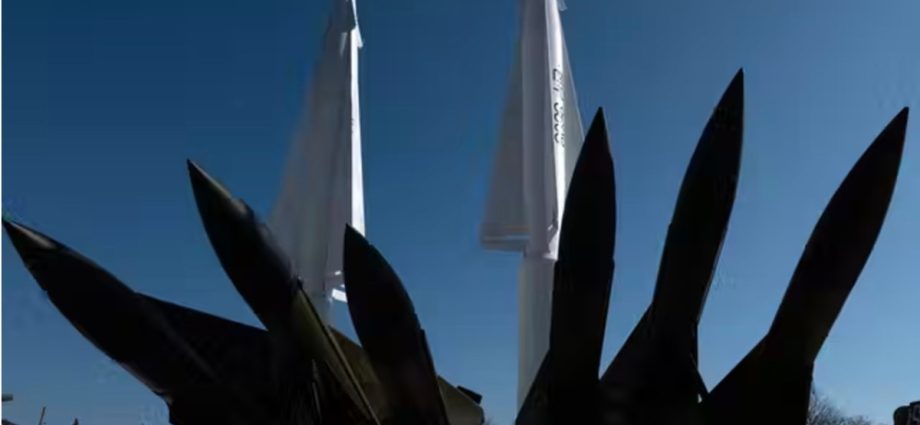South Korea has announced plans to build next-generation destroyers in the latest phase of a massive naval buildup of aircraft carriers, arsenal ships and conventional ballistic missile submarines.
Naval News reported that South Korea’s HD Hyundai Heavy Industries (HD HHI) has completed the basic design for the Korean next-generation destroyer KDDX, marking a significant milestone in the country’s naval combat vessel technology.
The KDDX is the first destroyer built entirely with domestic technology, including indigenous detection and combat systems and is reportedly on par with the Republic of Korea Navy’s (ROKN) most advanced destroyer, the “King Jeong-jo the Great” (KDX-III Batch-II), which is currently undergoing trials and expected to be delivered by the end of the year.
HHI showcased a mock design of the KDDX at the MADEX 2023 defense exhibition in Busan, South Korea, emphasizing the ship’s system integration and technological advancement.
The KDDX is equipped with the Hanwha Systems’ integrated mast (I-MAST), featuring a “Dual-Band Multi-Function Radar” that aims to achieve reduced radar cross section and underwater radiated noise, enhancing its survivability against enemy submarines and radar detection.
Naval News says that the KDDX will be equipped with a Mk 45 5-inch main gun, two CIWS-II systems, eight anti-ship missiles, KVLS-I and KVLS-II launch systems to accommodate the new naval version of the L-SAM missile and an integrated sonar system for anti-submarine warfare.
In addition, the source says the basic design includes a “manpower-reduction platform,” such as automated ammunition handling systems, a smart bridge and a navigational assistance system based on autonomous navigation technology, which has been incorporated to reduce crew requirements.
Naval News notes that the program’s total cost is US$5.8 billion, with plans for the Republic of Korea (ROK) Navy to acquire six vessels by 2036.
The KDDX is the next step in South Korea’s destroyer program, which has seen increasing indigenization and focus on missile defense.
In a 2021 article, Global Security notes that the requirement for the KDDX came about due to a need to maintain the capabilities of South Korea’s Aegis destroyers but with lower cost and operating expenses.
Global Security notes that South Korea has more than enough capability to build high-end naval combatants, as it has already localized its fleet, naval bases, and production of ship-to-air missiles and vertical launchers.

The source mentions that the ROKN is seriously considering “implementing a maritime-based Korean 3-axis system (kill chain, Korean-style missile defense, mass retaliation).”
Global Security adds that South Korea’s “ability to strike critical targets within the North Korean Command and the North Korean Ballistic Missile Operations Area (BMOA) will enhance the land attack and anti-submarine performance capabilities. “
The KDDX may work alongside South Korea’s planned arsenal ships, performing sea-based missile defense and anti-submarine protection, as the latter provides serious conventional firepower against North Korean inland targets.
In April 2023, Asia Times reported that South Korea had announced plans for an “arsenal ship,” a massive missile-laden vessel designed for land-attack missions against strategic targets like command centers, logistics hubs, air defense sites, and military infrastructure.
However, the concept has been criticized as vulnerable to enemy attacks, difficult to defend and easily detectable compared to submarines.
The ROKN selected Daewoo Shipbuilding & Marine Engineering (DSME) for its Joint Firepower Ship (JFS) concept, with plans to secure three vessels by the late 2020s. Each ship can carry 80 missiles for pre-emptive strikes on North Korean military facilities.
Together with the Republic of Korea Army’s (ROKA) Hyunmoo surface-to-surface missiles and the Republic of Korea Air Force (ROKAF) Taurus air-to-surface missiles, the JFS form a potent kill chain against North Korean missile threats.
North Korea’s changing strategic outlook toward South Korea may have given new impetus to Seoul’s military build-up, especially regarding sea-based missile defense.
This month, multiple media sources reported that North Korea is set to drop its constitutional commitment to reunification with South Korea, a clear break in its decades-long policy.
In explaining the rationale for that change, North Korean leader Kim Jong Un designated South Korea as his country’s principal enemy and mentioned that South Korean citizens are no longer regarded as “fellow countrymen.”
North Korean state media quoted Kim as saying, “The expressions ‘northern half’ and ‘independent, peaceful unification, and great national unity’ in our constitution should now be deleted.”
Kim also said that “the reality is that the North-South relationship is no longer a relationship of kinship or homogeneity, but a relationship of two hostile countries, a complete relationship of two belligerents in the midst of war.”

That apparent policy change raises significant new questions about North Korea’s willingness to use nuclear weapons against South Korea now that it has formally dropped its reunification goals and views the South as a foreign enemy.
That pronouncement may be intended to give North Korea more leeway in pursuing a brinksmanship policy, threatening the use of nuclear weapons to extract concessions from foreign powers such as the US while playing up a narrative of continuous hostility to win popular support for Kim’s regime.
The KDDX program also ties into South Korea’s aspirations of having a blue water navy, which serves multiple purposes and has significant implications for regional Security.
In a September 2013 article for The Strategist, Benjamin Schreer notes that South Korea’s blue water navy ambitions are driven by a desire to maintain overmatch against North Korea’s aging navy and to become a more significant player in Asian maritime security affairs.
Alexander Hynd mentions in a March 2022 article for La Trobe University that South Korea’s blue water navy push is driven partly by its desire to maintain strategic autonomy at home and abroad, with that goal being jeopardized if it were to be perceived as following one great power and antagonizing another.
However, Schreer points out that South Korea’s naval buildup could also raise tensions with China and Japan, especially as South Korea is involved in territorial disputes with China over Socotra Rock and with Japan over the Dokdo/Takeshima islets.

